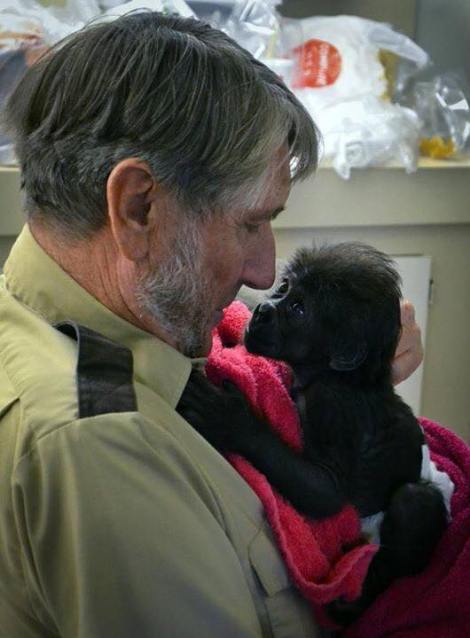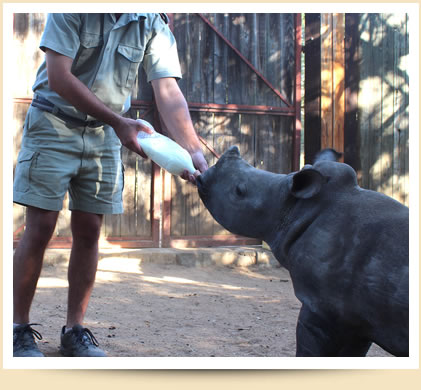
“In this photo taken on Tuesday, May 13, 2014, Park rangers stand next to the remains of elephants that were killed by poachers in the Garamba National Park, situated in the Democratic Republic of Congo. At least 68 elephants, some 4 percent of the population of one of Africa’s oldest parks, have been slaughtered by poachers over the last two months using chain saws and helicopters, warned the non-profit group managing the park. The Johannesburg-based African Parks group said that since mid-May, the 5,000 square kilometer (1,900 square mile) Garamba National Park established in 1938 has faced an onslaught from several different bands of poachers. (AP Photo/African Parks)”
It’s all out war against the elephant, one of the most sentient creatures on earth. They are being systematically slaughtered by poachers for their tusks and babies are being indiscriminately killed along with the adults.
“One group is shooting the elephants with rifles from a helicopter and then taking off their tusks with a chain saw. They are removing the elephants’ brains and genitals as well.
Conservationists say a thriving ivory market in Asia is helping fuel the worst poaching epidemic of African elephants in decades.”…AP
This is an international emergency! Why is the world standing by watching this slaughter and doing nothing? This is a disgrace. The elephant population in the park has gone from 20,000 in the 1960’s to only 2000 counted in a 2012 census. I’m sure the count is much lower now since the park has lost 4% of its elephant population.
Soon the only elephants left will be in zoo’s! Where is the UN?
Poachers massacre elephants in Congo park
RABAT, Morocco (AP) — One of Africa’s oldest national parks is under attack “from all fronts,” said its director Friday after 68 elephants were slaughtered over the past two months by poachers wielding chain saws and grenades and shooting them from helicopters.
Garamba National Park in the Democratic Republic of Congo is under constant assault by renegade Congolese soldiers, gunmen from South Sudan and others. And this is just a slice of the carnage: international wildlife regulators say 20,000 elephants were killed just in Africa in 2013.
The Johannesburg-based African Parks group, which manages the park, said that since mid-May, the 5,000 square kilometer (1,900 square mile) Garamba National Park in Congo, which was established in 1938, has faced an onslaught from several bands of poachers who have already killed 4 percent of its elephant population.
“The situation is extremely serious,” Garamba park manger Jean-Marc Froment said in the statement. “The park is under attack on all fronts.” A 2012 census found just 2,000 elephants in Garamba Park, down from 20,000 in the 1960s.
One group is shooting the elephants with rifles from a helicopter and then taking off their tusks with a chain saw. They are removing the elephants’ brains and genitals as well.
Conservationists say a thriving ivory market in Asia is helping fuel the worst poaching epidemic of African elephants in decades.
In some cases the attacks in Garamba seem to be indiscriminate, killing baby elephants that do not yet possess the valuable ivory tusks.
African Parks, which runs seven parks in six countries in cooperation with local authorities, said the poachers include renegade elements of the Congolese army, gunmen from South Sudan, and members of the Lord’s Resistance Army, a militant rebel group whose fugitive leader Joseph Kony is an alleged war criminal.
In one skirmish with poachers, park guards had to try to protect themselves from hand grenades thrown by Southern Sudanese poachers, some wearing military uniforms.
Froment singled out in particular elements of the LRA, which is notorious for its kidnapping children and using them as soldiers, and has been active in the park. In 2009, the group attacked the park’s headquarters, killing 15 park employees and family members.
The group is known to have a presence in the heavily forested areas around the park.
A spokeswoman for African Parks, Cynthia Walley, said the heavy vegetation and large concentration of elephants in the park have made it a target for poachers who have flocked to the area, leading to the sudden escalation in attacks.
“It’s pretty well documented that Garamba is one of the few remaining places where you get these large herds of elephants,” she said. “The supply of elephants in some parts of Africa for poachers has diminished and so in areas where you are protecting elephants you become a target.”
She said that African Parks, which has run Garamba in cooperation with the Congolese parks authority since 2005, beefed up their forces in anticipation of increased poaching this year but found recent spike to be “unprecedented.”
In addition to Congolese and park forces, there are units from the United States military’s African Command supporting anti-poaching efforts on the ground, African Parks said.
In recent years, the U.N. has warned that armed groups in Africa have been turning to ivory poaching to fund their struggles. Many are also using the more sophisticated weapons that flowed from Libya after the fall of Moammar Gadhafi in 2011.
The Geneva-based Convention on International Trade in Endangered Species of Wild Fauna and Flora said Friday that 20,000 elephants were killed in 2013, but the overall poaching was on the decline due to better law enforcement.
The spike in attacks on Garamba, however, suggests that poachers may just be shifting to different targets. Poaching has been down in Chad, for instance, while it has been on the rise in Central African Republic which is being wracked by a civil war.
http://news.yahoo.com/poachers-massacre-elephants-congo-park-101751904.html

Save The Elephants
http://www.savetheelephants.org/
===
Elephant Crisis Fund
Every 15 minutes an elephant is killed for its ivory tusks. Unless we act now, elephants face an uncertain future.
https://elephantcrisisfund.org/
===
With the elephant poaching epidemic in Africa running rampant — and renewed ivory lust growing worldwide — experts fear the survival of the species is at stake.
===
===
Top Photo: Courtesy AP Photo/African Parks
Bottom Photos: Wikimedia Commons
Posted in: Endangered Species, Animal Cruelty, Activism
Tags: elephant slaughter, barbaric poachers, Asian driven Ivory trade, save the elephant, African elephant, Garamba National Park















 Boulder White Clouds Council
Boulder White Clouds Council Exposing The Big Game
Exposing The Big Game Footloose Montana
Footloose Montana Friends of the Clearwater
Friends of the Clearwater Lockwood Animal Rescue Center
Lockwood Animal Rescue Center Louise du Toit
Louise du Toit LUPUSLAETUS
LUPUSLAETUS Mercy For Animals
Mercy For Animals Northern Idaho Wolf Alliance (NIWA)
Northern Idaho Wolf Alliance (NIWA) Predator Friendly®- Because Wildlife Matters
Predator Friendly®- Because Wildlife Matters Project Coyote
Project Coyote Project: Wolf
Project: Wolf The Nature Conservancy
The Nature Conservancy The Ravensong Group
The Ravensong Group WildEarth Guardians
WildEarth Guardians Wisconsin Wildlife Ethic-Vote Our Wildlife
Wisconsin Wildlife Ethic-Vote Our Wildlife Wolf And Wildlife Studies: Jay Mallonee (Independent Wolf Biologist)
Wolf And Wildlife Studies: Jay Mallonee (Independent Wolf Biologist) Wolf Song of Alaska
Wolf Song of Alaska Wolves in english ! Les loups en anglais !
Wolves in english ! Les loups en anglais ! WWP's Gray Wolf Page
WWP's Gray Wolf Page Yellowstone To Yukon Conservation Initiative
Yellowstone To Yukon Conservation Initiative